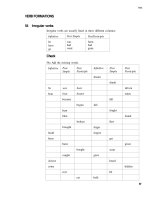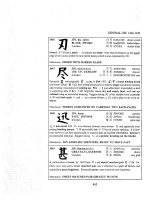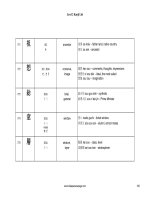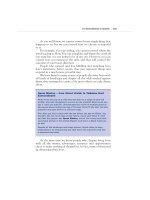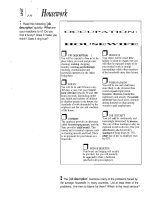Quantitative comparisons practice phần 8 pps
Bạn đang xem bản rút gọn của tài liệu. Xem và tải ngay bản đầy đủ của tài liệu tại đây (83.58 KB, 17 trang )
The best answer is A.
Cindy’s initial weight was 50 Kg. The question is how much is 15 out of
50 in percent terms:
%30%100
50
15
and therefore column A is greater
than column B.
13.
A: X
B: 15
AI: X percent of X are X/8
0
X
The best answer is B.
Rewrite the extra data in percent terms:
8
100
XX
X
. Multiply both sides
by 100 to get: 12.5 X = X
2
X = 12.5 and therefore column B is greater
than column A.
14.
A: The total decrease in the car’s value
B: 60%
AI: The value of a car decreased by 20% and then it decreased by 40%
more
The best answer is B.
Let’s say the car cost $100.
At first its price decreased to $80, then it decreased by 40%:
(0.6 x $80 = $48). The total decrease is (100 – 48 = 52%).
The car decreased by 52% and not by 60% and so column B is greater.
15.
A: The total increase in the stock’s value
B: 40%
AI: The value of a certain stock increased by 20% on January and by 20%
more on February
The best answer is A.
Let’s say that the value of the stock was $100.
In January it increased to $120.
In February it increased to (1.2 x 120 = $144).
All together, the stock’s value increased by 44%, which is greater than
40%.
16.
A: By how much percent are rollerblades more expansive than ice-skates
B: 80%
AI: Rollerblades cost 40% more than skateboards and skateboards cost
40% more than ice-skates
The best answer is A.
Let’s say that ice-skates cost $100 since there are no numbers in the
question. Skateboards cost 40% more, thus $140.
Rollerblades cost 40% more than $140, which is $196.
And therefore rollerblades cost 96% more than ice-skates, which is
greater than 80%.
17.
A: The average (arithmetic mean) of the rest of the grasshoppers
B: 5 Centimeters
AI: The average (arithmetic mean) of 15 grasshoppers is 8 centimeters.
The average of 5 of the grasshoppers is 10 Centimeters.
The best answer B.
Let’s say that the average of the rest of the grasshoppers in column A is
X.
Use the average formula: 643508
8
3510
X
X
.
3X = 14
3
2
4X , which is a little under 5 and therefore column B is
greater.
18.
A: The original number of bells that Helen had
B: 700
AI: After Helen lost 30% of her bells, she had 500 bells
The best answer is A.
500 bells are 70% of the number we are looking for.
We can write the following equation:
?
500
100
70
The original number
of bells is (50,000)/(70) = A little over 700 and therefore column A is
greater.
19.
A: The amount of sugar (in liters) in a mix containing 3 liters of
strawberry juice and 2 liters of cola
B: 1.5
AI: The concentration of sugar in strawberry juice is 20% and in cola it’s
40%
The best answer is B.
Calculate the amount of sugar in the mix:
20% of 3 liters is 3/5 liters plus 40% of 2 liters, which is 4/5 liters.
The total is (3/5 + 4/5 = 7/5 = 1 and 2/5 = 1.4 liters).
Column B is greater than column A.
20.
A: The probability of guessing the code the safe
B: 1/(100,000)
AI: The code of a safe has 5 digits.
The last digit is 0.
The best answer is A.
Since we already know the last digit, we need to guess only 4 digits.
Each digit can be between 0 and 9.
The probability of guessing each digit is 1/10 and therefore the
probability of guessing the whole 4 is (1/10)
4
= 1/(10,000), which is
greater than the expression in column B.
21.
A: 8
2
B: 2
8
The best answer is B.
Take the expression in column B and write it as followed:
2
8
= 16
2
, which is greater than column A.
22.
A: X
B: Y
AI: X
2
= 25 and 5Y
The best answer is D.
X can be either 5 or -5, Y can either be 5 or -5 also and since there can be
more than one answers to the problem, the right answer is D.
23.
A: X
B: 10
AI: X
2
= 81
The best answer is B.
X can either be -9 or 9.
10 is larger than both choices and therefore column B is greater than
column A.
24.
A: Y
B: 0.25X
AI: X and Y are both negative integers.
X/Y > 4
The best answer is B.
X/Y > 4 X > 4Y divide both sides by 4: 0.25X > Y and therefore
column B is greater than column A.
25.
A: X – 5
B: Y + 5
AI: -5 < -X < 5
-20 < -Y < -15
The best answer is B.
Simplify the ranges and make them compatible with the question:
-5 < -X < 5 5 > X > -5 0 > X – 5 > -10
-20 < -Y < -15 20 > Y > 15 25 > Y + 5 > 20
We can see that the expression in column A is negative while the
expression in column B is positive and therefore greater.
26.
A: (1/16)
0.5
+ (1/25)
0.5
B: (1/16 + 1/25)
0.5
The best answer is A.
Column A = (1/16)
0.5
+ (1/25)
0.5
= ¼ + 1/5 = 9/20.
Column B = (1/16 + 1/25)
0.5
= (41/400)
0.5
=
20
41
.
Now,
41
is smaller than 9 and therefore column A is greater.
27.
A: (9/144)
0.5
– (1/25)
0.5
B: (9/144 – 1/25)
0.5
The best answer is B.
Column A = (9/144)
0.5
– (1/25)
0.5
= 3/12 – 1/5 = 1/20.
Column B = (9/144 – 1/25)
0.5
=
20
3
60
9
3600
81
25144
144259
5.05.0
.
We can see that column B is greater than column A.
28.
A: 7/1000
B: 0.049/7
The best answer is C.
7/1000 = 0.007.
0.049/7 = 0.007.
The columns are equal to one another and so the answer is C.
29.
A: 0.6
3
B: 0.6
1/3
The best answer is B.
0.6 is also 3/5.
Column A = (3/5)
3
= 9/125.
Column B = (3/5)
1/3
we know that a power that is not a fraction makes
a fraction smaller, its also good to remember that a power that is a
fraction makes a fraction larger and therefore the expression in column B
is greater than 3/5 and obviously from 9/125.
30.
A: The average of (X + 9Y + 191) and (9X + Y + 347)
B: The average of (5X + 4Y + 457) and (5X + 6Y + 87)
The best answer is B.
Find the average in both columns:
Column A = (X + 9Y + 191 + 9X + Y + 347)/2 = (10X + 10Y + 538)/2 =
(5X + 5Y + 269).
Column B = (5X + 4Y + 457 + 5X + 6Y + 87)/2 = (10X + 10Y + 544)/2
=
(5X + 5Y + 272).
The best answer is B.
31.
A: 3.88
B:
17
The best answer is B.
We know that 416 and that 525 and therefore 17, which is found
between 16 and 25 will give a result between 4 and 5.
Column B is greater than column A.
32.
A: Percent increase from 63 to 65
B: Percent increase from 65 to 67
The best answer is A.
A = 2/63 and B = 2/65.
The denominator is bigger in B and therefore column A is greater.
33.
A: X + Y
B: X + Z
AI: The product of three numbers is 1000
The best answer is D.
All we know is that XYZ = 1000, this information is not sufficient to
know whether Y is bigger than Z or not. The right answer here is D.
34.
A: 0.1
B:
1
25
250
The best answer is C.
Column B = 1.0
10
1
250
25
25
250
1
and therefore column A and B are
equal.
35.
A: 65% of 135
B: 135% of 65
The best answer is C.
Remember, don’t calculate- compare.
A =
135
100
65
B =
65
100
135
According to the multiplication law, these expressions are equal and thus
the answer is C.
36.
A: 30% of 25
B: 65% of 15
The best answer is B.
A = 5.725
100
30
B = 75.9
100
975
15
100
65
Column B is greater than column A.
37.
A:
BA
B:
BA
AI: A > 0
B < 0
The best answer is B.
If A = -B for example, column A = 0 while column B = 2A or 2B.
The expression in column B is always positive as opposed to the
expression in column A, which can equal zero.
38.
A: (X + Y + Z)/3
B: Z
AI: X < Y < Z
The best answer is B.
The expression in column A is actually the average (arithmetic mean),
which means that its value is between X and Z, thus smaller than Z.
Since the average must be smaller than Z, column B is greater than A.
39.
A: The sum of the numbers
B: 2188
AI: The average of 12 numbers is 182
The best answer is B.
The average (arithmetic mean) of n numbers is their sum divided by n.
If the average of 12 numbers is 182, their sum will be 12 x 182 = 2184.
Column B is greater than column A.
40.
A: (23)
-1
B: (24)
-1
The best answer is A.
A = 1/23 and B = 1/24, in column A 1 is divide into less parts and
therefore the result is greater.
41.
A: A + B
B: 140
AI: A = 20 + 16 + 13 + 11 + 6 + 2
B = 22 + 18 + 13 + 11 + 8 + 4
The best answer is A.
Rewrite A and B like this: A = 20 + 16 + 13 + 11 + 6 + 2
B = 4 + 8 + 11+ 13 + 18 + 22
Add them up: A + B = 24 + 24+ 24 + 24 + 24 + 24
A + B = 24 x 6 = 144.
Column A is greater than column B.
42.
A: 2 x (0.2)
B: (0.2)
2
The best answer is A.
2 x (0.2) = 0.4.
(0.2)
2
= 0.04.
Since 0.4 > 0.04, column A is greater than B.
43.
A: Y
B: 2X + 3.5
AI: 4Y – 8X = 14
The best answer is C.
4Y – 8X = 14, divide both sides by 4: Y – 2X = 3.5 Y = 2X + 3.5.
We can see that the columns are equal to one another.
44.
A: 1.5 – 3X
B: Y
AI: 8Y – 24X = 12
The best answer is D.
Take 8Y – 24X = 12 and divide it by 8: Y – 3X = 1.5.
Y = 3X + 1.5.
We don’t know if 3X + 1.5 are bigger or smaller than 1.5 – 3X since X
can be positive, negative or even zero. The right answer is D.
45.
A: 11 out of 12 in percent terms
B: 91%
The best answer is A.
Column A =
12
100,1
%100
12
11
. Stop here.
Go to the other column and check if 12 x 91 is greater than 1100:
12 x 91 = 1,092 and therefore it’s more than 91%.
Column A is greater than column B.
46.
A: X – Y + Z
B: 15
AI: Y – X – Z > 15
The best answer is B.
Take Y – X – Z > 15 and divide both sides by -1:
X – Y + Z < -15 (don’t forget to flip the inequality)
We can see that the expression in column A is smaller than that in column
B.
47.
A: 4/9 + 5/12
B: 4/7 + 5/11
The best answer is B.
A = 4/9 + 5/12 =
108
93
108
4548
< 1.
B = 4/7 + 5/11 =
77
79
77
3544
> 1 and therefore column B is greater.
48.
A: 0
7
B: 7
0
The best answer is B.
Zero raised to any positive power is zero, so Quantity A = 0.
Any number raised to 0 is unity, so Quantity B = 1.
49.
A: 1
B: X
AI: 2
1
X
The best answer is A.
Since
X
1
is negative X must the negative.
If X is negative, column A is greater.
50.
A: 66
B: The average of the six numbers.
AI: The sum of 6 even consecutive numbers is 396.
The best answer is C.
The average is the sum divided by the amount of numbers.
The average of the 6 numbers is 396/6 = 66 and therefore the columns are
equal to one another.
51.
A: X
2
Y
3
B: X
3
Y
2
AI: X < 0 and Y > 0
The best answer is A.
Pick up numbers: For example, X= -1 and Y= 2.
Column A = 1 x 8 = 8.
Column B = -1 x 4 = -4.
We can see that column A is positive while B is negative and so A is the
right answer.
52.
A: The smallest prime number smaller than 4
B: 3
The best answer is B.
The smallest prime number smaller than 4 is 1 and not 3 and therefore
column B is greater than column A.
53.
A: 1 – 4/17
B: 27/68 + 17/34
The best answer is B.
Column A = 1 – 4/17 = 13/17 = 52/68.
Column B = 27/68 + 34/68 = 61/68.
Column B is greater than column A.
54.
A: (0.99)
3
(0.99)
4
B: (0.99)
8
The best answer is A.
When dealing with fractions, the smaller the power, the largest the result.
A = (0.99)
7
while B = (0.99)
8
and therefore column A is greater since the
power of the fraction there is smaller.
55.
A: X
B: 7
AI:
X 7
The best answer is B.
If X 7 , then –X = 7 and so X = -7.
7 > -7 and so column B is greater than column A.
56.
A:
168
5.125.2
XX
B:
4
5.1
X
The best answer is C.
Take a power of two on both sides to get:
A =
168
5.125.2
XX
.
B =
2
5.1
4X 168
5.125.2
XX
.
And so column A is equal to column B.
57.
A: 11
5
B: 100,000
The best answer is A.
100,000 can be written as 10
5
.
Now, 11
5
> 10
5
and therefore column A is greater than column B.
58.
A:
2
2Y
B: Y
The best answer is D.
For a positive Y, column A is equal to column B.
Now, for a negative Y, column A is greater than column B.
Since there is more than one answer, the right answer is D.
59.
A: X
B: 13
AI: XY = 156
Y < 11
The best answer is A.
156 is a multiplication of 12 and 13.
Since Y is smaller than 11, X must be larger than 13 in order for the
multiplication XY to be equal to 156.
Since X > 13, column A is greater than column B.
60.
A: 1/X – 1/Y
B: (X – Y)/(XY)
The best answer is D.
Simplify column B into the following: (X – Y)/(XY) = 1/Y – 1/X.
Since we have no further information on X and Y, the answer cannot be
obtained and the right answer is D.
61.
A: (X – Y)/(XY)
B: 0
AI: Y > X > 0
The best answer is B.
The easiest way is to plug in numbers.
Replace X with 1 and Y with 2.
Column A = (1 – 2)/(1 x 2) = -1/2.
Column B = 0.
Therefore, column B is greater than column A.
62.
A:
2
37
B:
2
46
The best answer is B.
Simplify both columns.
Column A =
212103212737
2
.
Column B =
242104242646
2
.
We can see that the expression in column B is greater than that in column
A.
63.
A:
99
999,999
B: 1111
The best answer is A.
Since its hard calculating the expression in column A, do the following:
Multiply 99 with 1111, the result is far less than 999,999 and therefore
column A is much bigger than column B.
64.
A: One half of 40% of 65
B: One fourth of 35% of 140
The best answer is A.
Column A = 13
10
260
2
1
65
100
40
2
1
.
Column B =
25.12
4
49
10
490
4
1
10
1435
4
1
140
100
35
4
1
.
We can see that column A is greater than column B.
65.
A: One seventh of 25% of 336
B: One sixth of 20% of 360
The best answer is C.
Column A = 12
7
84
100
8400
7
1
336
100
25
7
1
.
Column B =
12
6
72
362
6
1
360
100
20
6
1
.
We can see that column A = column B and so the answer is C.
66.
A:
5.9
25.0
5.0
10
5.01
5
B: 6.5
The best answer is B.
Simplify the expression in column A:
6
5.0
5.0
5
5.9
5.0
5.0
10
5.0
5
5.9
25.0
5.0
10
5.01
5
.
Column B is greater than column A by 0.5 and so the answer is B.
67.
A:
36
.
0
64
.
0
9645
B:
36
.
0
63
.
0
36177
The best answer is B.
Column A =
141
1
141
36
.
0
64
.
0
9645
.
Column B =
99
.
0
141
36
.
0
63
.
0
36177
, which is a little bigger than 141 and so
column B is greater.
68.
A: (X
2
+ Y
2
)
B: (X + Y)
2
AI: 0 > X > 1 > Y
The best answer is B.
Column A = X
2
+ Y
2
Column B = X
2
+ Y
2
+ 2XY, subtract X
2
+ Y
2
from both sides.
Column A = 0 while column B = 2XY.
2XY is greater than zero since X and Y are positive and therefore column
B is greater than column A.
69.
A: 7/5
B: Y/X
AI:
7
2
X
YX
The best answer is A.
Take
7
2
X
YX
and simplify it: 1 – Y/X = 2/7 Y/X = 1-2/7 = 5/7.
Column A is greater than 1 where column B is smaller than 1 and so the
answer is A.
70.
A:
0005
.
0
006.0
B:
0005
.
0
0008.0
The best answer is A.
Move the decimals to the right, keep track of how many you moved.
Column A = 12
5.0
6
0005.0
006.0
.
Column B =
5
8
0005
.
0
0008.0
, which is smaller than 12 and so column A is the
greatest.
71.
A: X + X
2
– X
3
+ X
4
B: X
4
– X
2
+ X
3
– X
AI: X = -3
The best answer is B.
The best way is to replace X with -3.
Column A = -3 + 9 – 27 + 81 = 60.
Column B = 81 – 9 + 27 – 2 = 97, which is greater than column A.
72.
A: Y – X
B: Y
AI: X and Y are positive prime numbers.
X + Y = 8, Y > X.
The best answer is B.
There are two choices: 1 and 7 or 3 and 5.
In the first option: X=1, Y=7; Column A = 6 and B = 7.
In the second option: X=3, Y=5; Column A = 2 and B = 5.
In both cases column B is greater than A and therefore B is the right
answer.
73.
A: Y – X
B: 7
AI: X and Y are positive prime numbers.
X + Y = 12, Y > X.
The best answer is D.
There are two choices: 1 and 11 or 5 and 7.
In the first option: X=1, Y=11; Column A = 10 and B = 7.
In the second option: X=5, Y=7; Column A = 2 and B = 7.
The answer is different each time and so the right answer is D.
74.
A: A + B
B: 18
AI: A x B = 17
The best answer is D.
A and B could be any numbers we want, for example: (1, 17) or (0.17,
100) or any other good combination. If we were told that A and B are
integers, the answer would have been C but no such information was
given and so the right answer is D.
75.
A: X
B: 9/39
AI: 13
111
X
X
X
The best answer is C.
13
3
13
3
13
111
X
X
X
X
X
.
Take the expression in column B: 9/39 = 3/13 and so both columns are
equal to one another.

